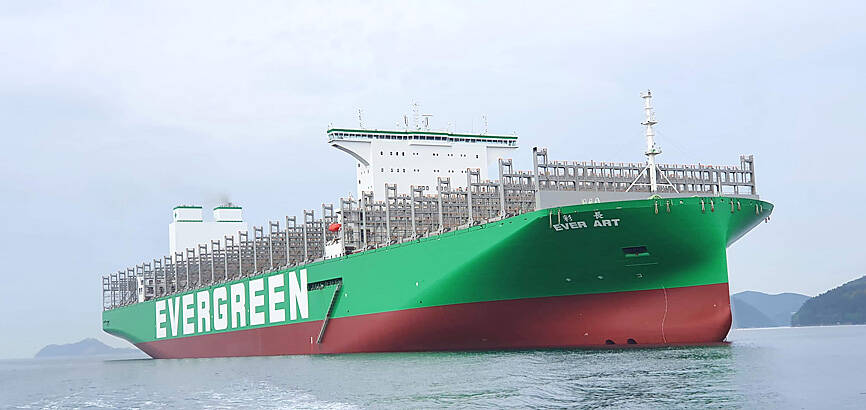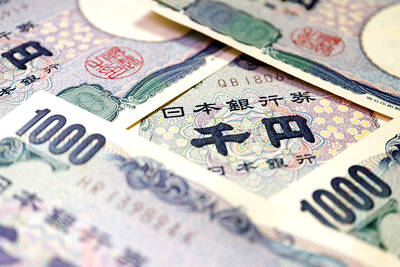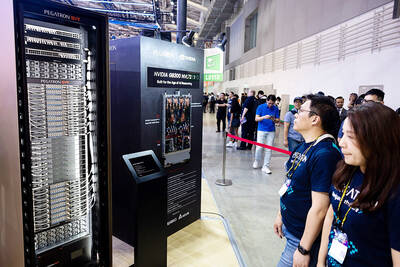Evergreen Marine Corp (長榮海運) and Yang Ming Marine Transport Corp (陽明海運) this year granted substantially large year-end bonuses to employees given strong profits, despite a decline in shipping rates this quarter.
Evergreen Marine, the nation’s largest container shipping company, distributed year-end bonuses of as much as 52 months wages to some of its employees yesterday, higher than the 40 months it offered last year, the Chinese-language Liberty Times (sister newspaper of the Taipei Times), reported yesterday.
Most employees were rewarded with year-end bonuses ranging from 10 to 45 months of wages, while those demonstrating superior job performances received the equivalent of 52 months of salary, the report said.

Photo courtesy of Evergreen Marine Corp
Evergreen declined to confirm the report or answer questions about the bonuses. It only said that each employee was compensated based on their performance.
Evergreen reported a net profit of NT$304.35 billion (US$9.91 billion) during the first three quarters of the year, up 92 percent year-on-year, or earning per share of NT$68.88, corporate data showed.
Evergreen’s local rival, Yang Ming Marine, planned to reward its employees with up to 13 months of their monthly salary, the Liberty Times reported yesterday.
The shipper’s net profit surged 51 percent year-on-year to NT$165.85 billion in the first three quarters of the year.
The company’s earnings per share were NT$46.97, up from NT$32.42 a year earlier, corporate data showed.
The shipping companies said that the significant revenue growth was a result of rising freight rates amid labor shortages and congestion at ports around the world amid the COVID-19 pandemic.
Evergreen shares gained 1.88 percent to NT$163, while Yang Ming shares rose 1.08 percent to NT$65.5 in Taipei trading yesterday.

AI TALENT: No financial details were released about the deal, in which top Groq executives, including its CEO, would join Nvidia to help advance the technology Nvidia Corp has agreed to a licensing deal with artificial intelligence (AI) start-up Groq, furthering its investments in companies connected to the AI boom and gaining the right to add a new type of technology to its products. The world’s largest publicly traded company has paid for the right to use Groq’s technology and is to integrate its chip design into future products. Some of the start-up’s executives are leaving to join Nvidia to help with that effort, the companies said. Groq would continue as an independent company with a new chief executive, it said on Wednesday in a post on its Web

RESPONSE: The Japanese Ministry of Finance might have to intervene in the currency markets should the yen keep weakening toward the 160 level against the US dollar Japan’s chief currency official yesterday sent a warning on recent foreign exchange moves, after the yen weakened against the US dollar following Friday last week’s Bank of Japan (BOJ) decision. “We’re seeing one-directional, sudden moves especially after last week’s monetary policy meeting, so I’m deeply concerned,” Japanese Vice Finance Minister for International Affairs Atsushi Mimura told reporters. “We’d like to take appropriate responses against excessive moves.” The central bank on Friday raised its benchmark interest rate to the highest in 30 years, but Bank of Japan Governor Kazuo Ueda chose to keep his options open rather than bolster the yen,

Even as the US is embarked on a bitter rivalry with China over the deployment of artificial intelligence (AI), Chinese technology is quietly making inroads into the US market. Despite considerable geopolitical tensions, Chinese open-source AI models are winning over a growing number of programmers and companies in the US. These are different from the closed generative AI models that have become household names — ChatGPT-maker OpenAI or Google’s Gemini — whose inner workings are fiercely protected. In contrast, “open” models offered by many Chinese rivals, from Alibaba (阿里巴巴) to DeepSeek (深度求索), allow programmers to customize parts of the software to suit their

Global server shipments are expected to surge to 15 million units next year, from 4 million units this year, with artificial intelligence (AI) servers accounting for about 30 percent, driven by massive capital spending by major cloud service providers, the Market Intelligence and Consulting Institute (MIC) said on Thursday last week. Major cloud service providers — including Google’s parent company Alphabet Inc, Microsoft Corp, Amazon.com Inc and Meta Platforms Inc — are projected to budget US$450 million for capital expenditure next year, up from US$400 million this year, MIC ICT [information and communications technology] Industry Research Center director Edward Lin